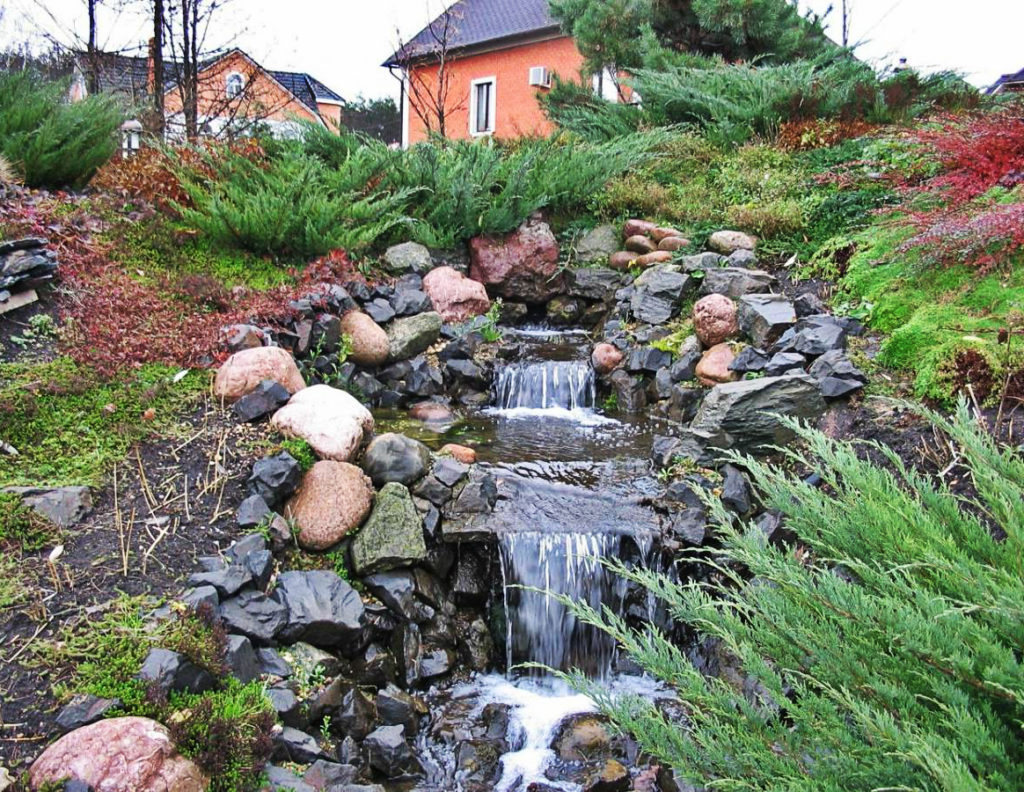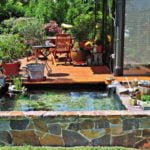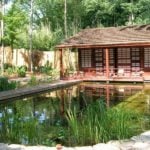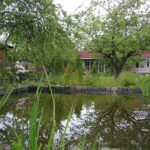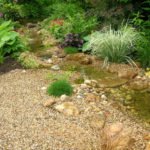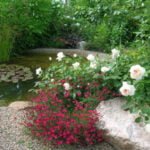A stream in the country assumes the presence of at least a small pond on the site, and if there is none? In this case, you can create a small pond with your own hands. It’s so nice to have a pond on the territory of the cottages. In addition, the stream will saturate the pond with oxygen and will not allow the water to stagnate. This is the mini-circulation of water on your site.
Having even a small pond, it will not be difficult to make a stream on the site. To equip it, a powerful pump is installed at the bottom of the source tank, from which hoses or polypropylene pipes are stretched along the entire streambed. Then the tank is filled, the pump is turned on, water is supplied under pressure to the source of the stream, and then a thin trickle returns “home” to the pond again. The coast is decorated to taste. Now let’s see how to do it right.
Layout of the garden creek canal
The flow of the stream will be determined immediately and will depend on the terrain of your site. If the slope under the stream is gentle, it will flow slowly, without a soothing murmur. But to create a bubbling stream, you will need steep slopes and large boulders in the center of the channel, from which water will fall in a continuous stream.
When planning a streambed, use the natural terrain. The stream can bend around your flower beds, flow next to trees, splash near recreation areas or wander around beautiful sculptures in the garden somewhere, creating a backwater and several small waterfalls, shoals or islands. Make it as natural as possible by observing the smooth natural shapes. Some summer residents spend the streambed along the garden paths, trying to give it the correct geometric shape. But replacing natural lines with strict geometry does not look very aesthetically pleasing, in addition, such a stream in the country often turns into an ordinary ditch and may well wash out your garden paths with heavy rains. At the planning stage of the streambed, think about creating an artificial waterfall, it will depend on the length of the stream and the area where it flows.

The shores of ponds can be decorated with beautiful flowering plants that love constantly moist soil: sedge, filipendula, hosta, badan and others. Choose the length and width of the streambed at your discretion, but standard sizes usually vary between 0.5-1.5 m (1.6-4.9 ft) – width and 0.3-0.5 m (1-1.6 ft) – depth.

Steps to create a stream
Step 1. So, you have decided on the terrain and decided where your stream will flow. Now arm yourself with a rope and pegs and walk along the bed of the future stream, driving the pegs close to each other and loosely connecting them with a rope (we do not need strict geometry).
Step 2. Dig the ground under the streambed to the depth you have planned. Add steps if the slope allows. Instead of thresholds on a steep riverbed, it is possible in some places to fix large boulders or make masonry, but the riverbed must be thoroughly cleaned of stones, plant roots and compacted earth. If you are building a large stream, it is better to concret its bed, and in the places reserved for thresholds, lay flat stones and fix them with concrete mortar.
Step 3. You may want to build a creek mouth and decorate it with aquatic and coastal plants (for example, as in this photo).

In this case, from the edge of the pond, where the stream will flow, the waterproofing coating is exposed and a trench is made for the mouth. Sprinkle it with a layer of sand or rubble 5-7 cm (2-2.7 in) high, then cover it with geotextile so as to get a margin at the edges. Then thoroughly moisten the geotextile fabric (you can pour water from a hose). This is done so that the geotextile fits snugly to the mouth. Then fix the canvas on each side with large stones, and in the middle of the channel make masonry: put flat stones, fixing them with concrete mortar. On top of the masonry, apply another layer of concrete mortar and decorate the structure with pebbles.
Step 4. Dig a shallow (10 cm/3.9 in) groove parallel to the streambed and put back the hoses (or pipe) from the pump. Fill in the grooves and mask them with a layer of turf. Connect the hose to the pump, then you can start the pump and the water should start flowing.
There are a lot of other ways to build a stream with your own hands, but more about this in the next article. I have described the easiest way that even a novice summer resident can cope with.
What plants to plant on the bank of the stream
Along the entire route of the stream along its banks, you can lay out beautiful rounded stones, alternating them with moisture-loving plants: stunted moss, primroses, daylilies, matteuccia, tracheophyta and others. And the streambed is usually decorated with creeping plants: a juga, lysimachia, veronica, etc., which gives it a piquant decorative effect. It is better to plant all plants in the flow path in groups to give the landscape a natural naturalness. Also, the banks and the mouth of the stream can be beautifully decorated with plants with a crown hanging down to the water, for example, salix caprea or caragana arborescens. And a little further away, you can plant jasmine, forsythia or syringa and enjoy not only the sound of water, but also the wonderful smells of flowers.

Care of the stream
If you built the stream correctly, taking into account all the features of the terrain, then further care of it will not be difficult. You only need to adhere to the following rules:
- If necessary, add fresh water to the tank where the pump is installed, as it eventually goes into the ground.
- Drain the tank completely and fill it with fresh water once a year.
- Keep the submersible pump in order: clean the filters regularly and check the hoses (pipes).
- Clean decorative stones from silt on the shore as they become dirty.
- In winter, it is better to drain the stream, completely freeing it from water.
